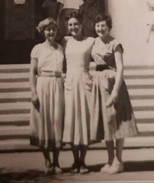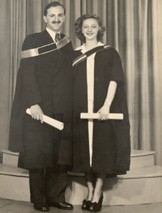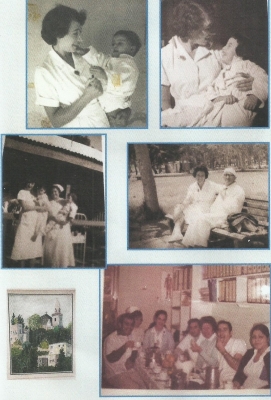Hazel Levy
 A team of nurses and two South African physiotherapists outside Sarafand Hospital. Hazel Levy, sitting bottom right. Sandra Saber sitting, first left.
A team of nurses and two South African physiotherapists outside Sarafand Hospital. Hazel Levy, sitting bottom right. Sandra Saber sitting, first left.
Living through a pandemic is definitely not one of the scenarios I might have imagined could ever happen to me. After all, vaccinations have been protecting our lives for so long. Until recently, it didn`t seem even vaguely possible that the entire world could be thrown by a new virus, losing all grip on our wellbeing, as is evident today. And even thinking about HIV as an epidemic is not realistic, for the route of transmission is far clearer and avoidable. True, I do recall seeing my grandmother Celia`s smallpox vaccination marks on her arms, for she had been allergic to the shot, but that`s as far viral threats went for me. The taste of the syrupy polio vaccine we received at school in the late 1950s in Cape Town, standing in line with classmates, hardly impressed me as it should have. There is no doubt that its discovery is probably one of medical science`s greatest achievements.
And so, yesterday, when my cousin Derick asked me to translate a document he found of his mother`s stay in Israel between 1950-1951, I was both surprised and interested to read that his mother Hazel, my father`s sister, played an important role in the treatment of children with polio in Israel in the early 1950s.
The report was written by the medical director of the Sarafand Hospital, housed in British army barracks just outside of Tel Aviv which served a population of mostly new immigrants with large families living in crowded conditions. The letter stated that the hospital would fully support Hazel spending time in England in order to gain further experience in rehabilitation. The director had plans that she would return and teach her skills to other therapists in Israel.
But, let me go back a bit…
My aunt Hazel Loon, born of immigrant parents from Eastern Europe, the sister of Donny, qualified as a physiotherapist in 1948 at the University of the Witwatersrand, Johannesburg. It was a four-year BSc degree. After a year of working, she joined the initiative of a group formed for the purpose of travelling to Israel to assist in the polio epidemic. Polio was the first epidemic to hit modern Israel three quarters of a century ago; Covid is the second, some seventy years later.
The illness was rife in the young country which was hopelessly under-equipped to handle the crisis. At the time, polio affected 128 of 1,000 citizens. The mortality rate was high- 10-12% in some areas; thirty percent of children would remain permanently paralyzed. Most of these severely affected were only five years old or younger.
After the creation of the state of Israel, many South African doctors left to work in the new country. Enthusiastic and glowing reports of their service were received back home. The then chairman of the South African Zionist Federation, Bernard Gering, a dynamic leader in the Jewish community, assembled a team of physiotherapists, as well as a physician, Dr Lomey, to assist in the rehabilitation of sick children with neurological symptoms of the illness. Together with other colleagues, Hazel, her friends Sandra Saber and Barbara Gordon, all in their early twenties, took up the challenge.
They arrived in Israel and immediately set to work. As in the rest of the world, the country was in the midst of an awful epidemic, similar to Covid 19 today. The numbers of sick children were increasing rapidly. Parents were anxious about the safety of their families and measures to prevent the infection spreading were varied and born of fear and lack of knowledge of just about every aspect of the virus` properties. The summer of 1950 was hot and measures to prevent the spread included cancelling most holiday plans of school or youth movement trips, or visits to the sea. Families stayed home; trips to the cinema were out of bounds for fear of spreading the illness.
Attempts were made by the Ministry of Health to curb the anxiety, but panic and uncertainty set in and rumours relating to the spread of the illness were the order of the day. There was very little professional knowledge about how to treat polio and prevent the deformities. Babies were hospitalized in hospitals which were often far from home and visits forbidden. There were several stories of children who died without a parent present to assist in the dramatic complications of strict hospitalization. For a country so young, that had so many wounds to heal, the epidemic was indeed a devastating event.
The practice then of quarantining patients with polio reminds me of today`s reality with Covid 19. Patients with severe complications are isolated in special wards, examined by medical staff whose identity is mostly lost, dressed in their protective clothing. Communication is minimal. The entire experience of hospitalization is traumatic.
Physiotherapy hardly existed in Israel in 1950; There was only a handful of workers in the field and so the arrival of professional therapists who had knowledge and skills in the field was a godsend.
Sarafand hospital, which hosted the team of physiotherapists, was small. It lacked beds, qualified staff, and in short, was ill-equipped to hospitalize and treat the sick children for long periods.
Acting quickly to overcome the desperate situation that existed, the Ministry of Health together with directors of the hospital drew up a plan whereby rehabilitation would be done at home. This spontaneous decision was revolutionary for the times and is still daring, even today. Discharging sick children to recuperate and rehabilitate at home.
And so it was that children were sent home after short hospitalizations to be looked after and treated by their parents, usually the mother, since the fathers were trying to make a living. Before discharge, each child was examined by the team and a program drawn up. This consisted of exercises and general measures to improve mobility and ensure safety.
Communication was a huge challenge since in most cases there was a language problem! Despite this, each physiotherapist outlined the main objectives to the mothers, usually with illustrations relevant to the child`s needs. She would focus on how to hold the child, help him out of bed, suggested how to improvise at home with aids, making use of what there was: tables, chairs, a plank of wood, talcum powder to name but a few.
There were obvious advantages to discharging the children home. They could recuperate in their own familiar surroundings, enjoy treatment of caregivers who were family members and not strangers in the hospital. Regular appointments of parent and child were set up at the Sarafand hospital during which the physiotherapist would check progress, correct the approach of the parent, and if necessary, consult with the orthopaedic surgeon about specific issues. Children were then invited back for follow-up as needed.
Decades have passed since the polio epidemic and once again the question of rehabilitation at home has become a viable option in many countries. We know that the home setting offers many advantages, especially in mild cases of neurological damage.
During the polio epidemic, there were many parents who opposed early discharge. Remaining on in the hospital freed them to carry on working and relieved the financial burden of another mouth to feed at home. Many were of the opinion that treatment was best given by experienced health workers and not family members.
Hazel loved the time she spent in Israel. There must have been something very rewarding being able to help, hands on, in an epidemic, affecting mainly children. She was a keen sportswoman and, although petite, was strong, energetic and courageous. I am sure that had there been ice rinks or golf courses in Israel, she would have been the champion, but of course that was yet to be! Hazel did have a few South African cousins in Israel with whom she was very close. They had settled on kibbutz in the north of the country, and when possible, she would travel to spend time with them. As fate would have it, Hazel returned to visit the family in Johannesburg after a year, met her future husband Leslie Levy - a young general practitioner, and so returning to Israel was put on hold.
And I can`t leave this remarkable, trying and yet inspiring time in a young country without mentioning the impact of the timing and presence of the South African team. They served as the trigger for the first school of physiotherapy to be set up at the Assaf Harofeh Hospital (Sarafand) in 1953. Sandra Saber, Hazel`s colleague, was sent to England to learn the ropes of teaching. In the new physiotherapy school, she did just that, and sometime after, actually directed the school. In 1954, a rehabilitation unit was established at the very same hospital. In its initial stages, the methods used by the pioneering team were continued. Sandra`s career was dynamic and productive as she went on to head the physiotherapy unit of the hospital for many years.
Comparing the management of the two epidemics which occurred decades apart, it is clear that resources today are far better than those of the early 1950s. In the light of my personal experience of home-care and Covid 19, the polio rehabilitation program under such trying conditions is all the more impressive. I can really appreciate the pioneering and creative spirit of management then and what it achieved with far less scientific knowledge and expertise available.
Moreover, I have gained insight into my aunt Hazel and what she accomplished in a country far away from home, coping in conditions that were certainly lacking, without a common language with her patients, but with a determination that can only be admired.
How I would have loved to chat to her about those years of intense work in a field I am so familiar with. We lived in the same town, our families` lives were intertwined and yet it never came up! It really isn`t surprising that the profession of her choice was also that of two of her children and that a grandchild is about to embark on the same career!
On reflection, am not all that surprised that my admiration for physiotherapists, whom I see as kind, warm and caring professionals, might very well be based on what Hazel represented for me.
Postscript:
Thanks to Gila Shahar, Deputy Director of Physiotherapy in the Ministry of Health and Noga Gal, current director of the School of Physiotherapy, Assaf Harofeh, for the information they shared with me in the investigation of this story. Also, thanks to the efficient team in the Jewish Board of Deputies in South Africa for checking out the archives for this article and forwarding the results to me.
See also: this follow up on the story of Hazel Levy
Rachel Rashbash read Gail Loon-Lustig's story on her aunt Hazel Levy. Rachel then contacted Gail to tell her that her own sister Barbara had been one of the three physiotherapists that Gail had written about. Below Gail writes of her visit to Rachel.
I so enjoyed my meeting with Rachel Rashbash in her cosy apartment at Neve Efal, Ramat Gan. We sat opposite a window with a view of trees in the distance. On the table was a superb arrangement of flowers that Rachel had made.
I was amazed at the story of Barbara, Rachel`s sister, who was one of the threesome who accompanied my aunt, Hazel Levy to Israel in the early 1950s. The three of them worked with children with polio and had a fascinating time all round in Israel over those months.
What was so touching is that Barbara actually described many aspects of living together near the hospital, their visits to Tel Aviv, their difficulties with the language which they overcome and the ultimate successful visit it was.
After studying both nursing and physiotherapy in England, Barbara travelled to South Africa at the invitation of her cousins in Johannesburg and it was there that she met the group leaving for Israel which she joined.
Rachel herself has a fascinating life`s story. She has always been interested in her family`s history, her father being a GP in London in the 1930s. He left Lithuania for London and was very successful at integrating into the community soon after qualifying at Medical School in England.
Remarkable in this story is that both Rachel and Barbara met my parents in the retirement home all those years later.
So it goes.
Gail Loon-Lustig,
Givatayim










Comments